Treatment with the help of the patient’s own information
in the BICOM® mobile VET bioresonance device
In contrast to other “frequency therapy devices”, BICOM® bioresonance is a method that is highly individual and perfectly tailored to the needs of the patient through the use of the patient’s own information and the possibility of testing specific wave patterns for resonance.
The patient’s own pathological and physiological information is recorded using special applicators and fed into the BICOM® mobile VET.
Depending on the therapy program, the specific wave pattern as a carrier of information is amplified, weakened or inverted and transmitted back to the patient in modulated form, which means that the transmission of information changes in clarity depending on the modulation or it disappears completely.
The treatment signals continuously adapt to the changing pathological situation of the patient. As the therapy progresses, the body’s ability to regulate is reactivated.
Find out more about this topic at our regular events. Together with veterinarians and animal naturopaths, we offer various face-to-face and online events .
The BICOM® bioresonance method is a cause-oriented, holistic treatment concept. It can narrow down the cause of the health problem in animals and find out even the hidden causes of the clinical picture.
Animals have a natural regulatory system that can also compensate for unusual influences. However, even good self-healing powers eventually reach their limits. Persistent exposure to allergens, environmental toxins, fungi, viruses, bacteria or stress and changed living conditions weaken the immune system and are often the cause of an illness. In particular, fungal infestation on the skin or chronic diseases in general are not always due to a breeding-related genetic defect, but are signs of a disturbed immune system.
The BICOM® bioresonance method is the key to successful diagnosis and therapy, especially for animals that cannot tell us exactly where it hurts or what the symptoms are. It is a gentle form of therapy that can be carried out without side effects and without additional stress for the animal.
The BICOM® mobile VET records the bioenergetic state of the animal, processes the information it contains and returns modified vibrations / therapy frequency patterns to the animal. Symptoms and stress can be diagnosed and targeted therapy can be initiated.
Through the use of endogenous and exogenous substances, the body’s own self-healing powers can be activated and imbalances that have existed for a long time can also be regulated.
REGUMED Medizintechnik are pioneers of the BICOM® bioresonance method. More than 30,000 therapists worldwide, well over 10,000 of them in Germany, successfully use their therapy concept.
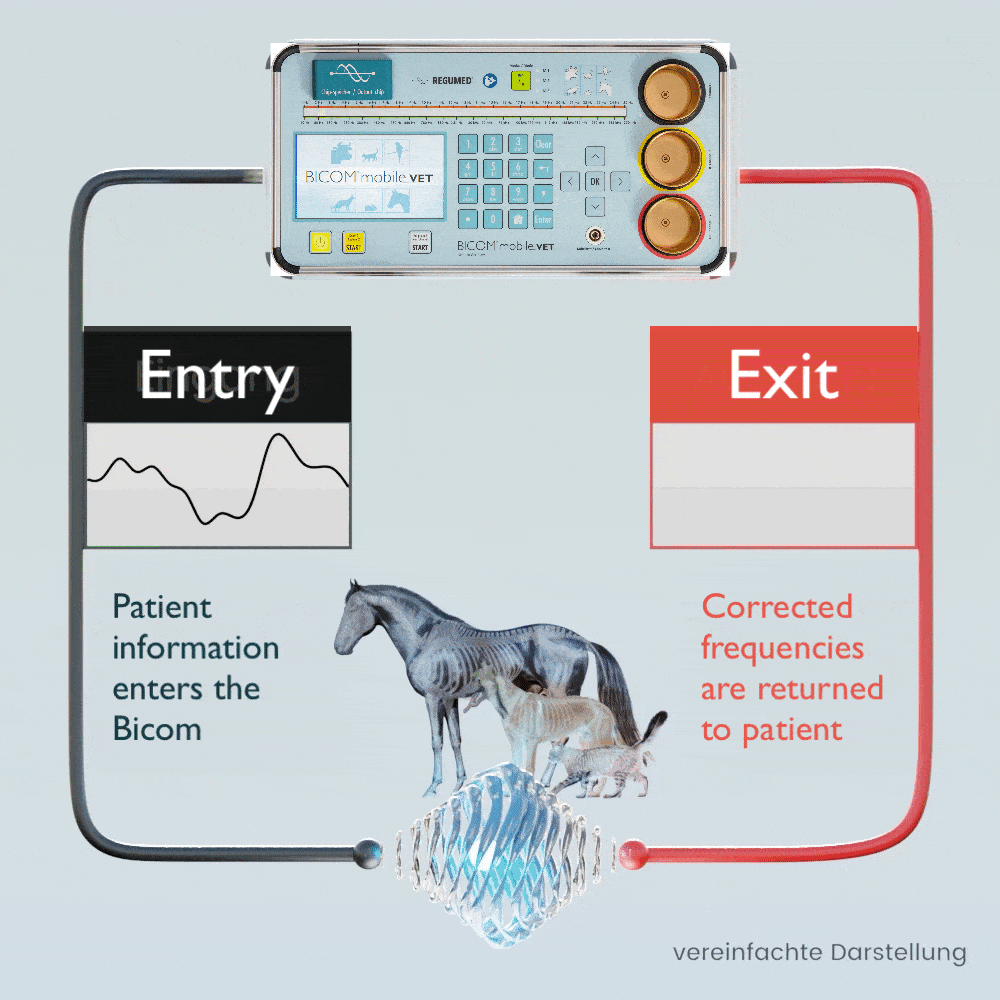
Biophysical basics of the bioresonance method
Life is only possible when three conditions are met: matter, energy and information.
We also find these aspects in conventional medicine, both in diagnostics and in therapy. For example, every drug is also a carrier of information.
Information is neither energy nor matter, it is immaterial and comparable to the meaning of a message from a sending to a receiving system.
In addition to the electrical processes in the receptor proteins and biomembranes in general, electromagnetic interactions through light (biophotons) also play a role in cell communication and the transmission of information.
Specific electromagnetic wave patterns act as information carriers. These wave patterns can be modulated by the BICOM® device in order to eliminate disturbing or stressful information in an organism.
The goal is to restore the free flow of healing information (cell communication) and thus support the self-regulation of the organism and the self-healing powers.
Individual, patient-specific information or information from native substances, digitized substances or information stored on storage media can be used for therapy.
What your colleagues are saying…

Bioresonance Cancer Treatment: Holistic Support for Healing
Bioresonance Cancer Treatment: Can It Support Your Recovery?
What Is Bioresonance Cancer Treatment?
Bioresonance cancer treatment is a form of alternative therapy that focuses on restoring the body’s natural electromagnetic balance. Every cell in the human body emits specific frequencies, and when these frequencies are disrupted, diseases like cancer may develop.
This therapy uses specialized bioresonance devices to scan the body for abnormal frequency patterns and correct them by transmitting healthy, harmonizing frequencies. Many practitioners and patients believe that this can help the body heal itself, reduce cancer-related symptoms, and enhance overall wellness.
Although bioresonance is not a replacement for conventional treatments like chemotherapy or radiation, it is gaining attention as a complementary approach that may support the healing process.
How Does Bioresonance Cancer Treatment Work?
Bioresonance therapy operates on the principle that cancer and other diseases create electromagnetic imbalances in the body. The treatment process involves three key steps:
1. Detection of Abnormal Frequencies – A bioresonance device scans the body and identifies frequencies associated with unhealthy cells, including those linked to cancer.
2. Frequency Correction – Once abnormal frequencies are detected, the device sends back therapeutic electromagnetic signals to neutralize these imbalances.
3. Stimulation of Self-Healing – By correcting these disruptions, bioresonance therapy aims to enhance the body’s natural healing capabilities, potentially helping to reduce symptoms and improve overall well-being.
Some practitioners also claim that bioresonance can aid in detoxification by helping the body eliminate harmful substances that may contribute to disease progression.
Scientific Research and Expert Opinions
The effectiveness of bioresonance cancer treatment is still a topic of debate within the medical community. While some studies suggest that electromagnetic therapies may influence cellular activity, large-scale clinical trials specifically proving bioresonance’s impact on cancer are limited.
Anecdotal evidence from patients suggests that bioresonance therapy may help in:
Reducing stress levels – Chronic stress is known to weaken the immune system and slow down recovery.
Improving immune function – A well-functioning immune system is essential for fighting cancer and preventing further complications.
Alleviating side effects – Some patients report experiencing less nausea, fatigue, and discomfort when using bioresonance alongside chemotherapy or radiation.
However, mainstream medical professionals emphasize that bioresonance should not be seen as a standalone cure for cancer. More scientific research is needed to determine its true efficacy.
Potential Benefits of Bioresonance Cancer Treatment
While bioresonance cancer treatment does not claim to cure cancer, many patients turn to it for potential benefits, including:
1. Non-Invasive and Painless Treatment
Unlike chemotherapy, radiation, or surgery, bioresonance therapy is completely non-invasive. There are no needles, medications, or surgical procedures involved, making it an attractive option for those looking for a gentle complementary treatment.
2. Possible Symptom Relief
Some cancer patients experience improvements in symptoms such as pain, fatigue, and nausea when undergoing bioresonance therapy. This is especially valuable for those undergoing aggressive treatments that cause severe side effects.
3. Enhanced Energy Levels
Cancer and its treatments often lead to extreme fatigue. Patients undergoing bioresonance therapy have reported feeling more energized, which may improve their ability to maintain a better quality of life.
4. Supports Detoxification
Some bioresonance practitioners claim that the therapy helps detoxify the body by eliminating harmful substances. While the scientific basis for this is unclear, many patients feel that the therapy helps them feel cleaner and more balanced.
5. Stress Reduction and Emotional Well-Being
Mental health plays a crucial role in the healing process. Bioresonance therapy sessions are often described as relaxing, which may help reduce anxiety and stress—factors that can negatively impact recovery.
Limitations and Considerations
Although bioresonance cancer treatment offers many potential benefits, there are also important factors to consider:
1. Lack of FDA or Medical Approval
Bioresonance therapy is not widely recognized or approved by major health organizations such as the FDA, WHO, or cancer research institutions. While some alternative medicine clinics offer it, mainstream healthcare providers generally do not recommend it as a primary treatment.
2. Limited Scientific Evidence
While some small studies and anecdotal reports suggest that bioresonance may support overall well-being, there is no solid scientific proof that it can treat or cure cancer. More rigorous research is needed to validate its claims.
3. Results Vary from Person to Person
Like many alternative treatments, bioresonance therapy does not have guaranteed results. Some patients report significant benefits, while others notice little to no difference. Factors such as individual health conditions, lifestyle, and conventional treatments being used may influence the outcome.
4. Should Not Replace Conventional Treatments
Experts strongly advise that bioresonance should be used as a complementary therapy rather than a substitute for conventional cancer treatments like chemotherapy, radiation, or surgery. Patients should always consult their oncologists before starting any alternative treatment.
What to Expect During a Bioresonance Therapy Session?
A typical bioresonance therapy session is simple and non-invasive. Here’s what happens:
1. Electrode Placement – Small electrodes or magnetic sensors are placed on the patient’s body. These electrodes are connected to the bioresonance machine, which scans for frequency imbalances.
2. Scanning Process – The device detects electromagnetic disturbances that may be linked to cancer or other health issues.
3. Correction Phase – The machine sends specific frequencies to help restore balance, aiming to strengthen the body’s natural defenses.
4. Session Duration – Each session usually lasts between 30 and 60 minutes. Patients may feel relaxed, energized, or notice no immediate change.
Some practitioners recommend multiple sessions for long-term benefits, while others use bioresonance alongside dietary and lifestyle modifications for enhanced results.
Is Bioresonance Cancer Treatment Right for You?
Before considering bioresonance cancer treatment, it is essential to discuss it with your healthcare provider. Here are some key points to consider:
If you are undergoing conventional cancer treatment, bioresonance may be used as a supportive therapy but should not replace medical care.
If you are seeking alternative options, ensure you consult with a licensed practitioner experienced in bioresonance therapy.
If you are looking for symptom management, bioresonance might help with stress reduction and energy balance, but results vary.
Can Bioresonance Help Strengthen the Immune System?
One of the key claims made by bioresonance therapy practitioners is that it may help strengthen the immune system. Cancer weakens the body’s natural defenses, making it harder to fight infections and recover from treatments like chemotherapy or radiation.
Bioresonance therapy is believed to work by detecting and neutralizing harmful frequencies, which may help the body regain balance. Some alternative health practitioners suggest that this process could support the immune system by:
Reducing inflammation – Chronic inflammation is linked to cancer progression and weakened immunity.
Improving cell communication – Restoring proper electromagnetic frequencies may enhance cellular function.
Aiding detoxification – By eliminating toxins, the body may become more resilient against infections and disease.
While scientific research on these claims is still ongoing, some patients have reported feeling stronger and more resilient after undergoing bioresonance therapy.
Integrating Bioresonance with Other Holistic Approaches
Many patients interested in bioresonance cancer treatment also explore other holistic healing methods to improve their well-being. While bioresonance focuses on energy balance, combining it with additional wellness strategies may enhance overall results. Some complementary approaches include:
Nutritional Therapy – Eating a nutrient-rich diet can support the body’s healing process and boost energy levels.
Mind-Body Techniques – Practices such as meditation, yoga, and acupuncture may help reduce stress and improve mental health.
Herbal and Supplement Support – Some natural supplements, like medicinal mushrooms or antioxidants, may promote cellular health.
Detoxification Therapies – Infrared sauna sessions, lymphatic drainage, and hydration strategies may assist in removing toxins from the body.
By integrating bioresonance therapy with other wellness approaches, some patients aim to create a more balanced and holistic cancer recovery plan. However, it’s essential to consult a healthcare professional before making significant changes to treatment routines.
Conclusion
Bioresonance cancer treatment is gaining attention as a non-invasive, complementary therapy that may support overall well-being. While some patients report benefits such as reduced symptoms, increased energy, and better emotional balance, scientific research on its effectiveness remains limited.
Patients considering bioresonance therapy should approach it as a complementary option rather than a replacement for conventional treatments. Always consult a qualified healthcare provider before starting any alternative treatment to ensure it aligns with your overall health plan.
FAQs
1. What is bioresonance therapy?
Bioresonance therapy is an alternative treatment that uses electromagnetic frequencies to detect and correct imbalances in the body. It is often used to support overall health and wellness.
2. Can bioresonance cure cancer?
There is no scientific evidence that bioresonance can cure cancer. It is considered a complementary therapy that may help with symptom management and overall well-being.
3. How does bioresonance therapy work?
A bioresonance device scans the body for irregular frequencies and then transmits corrective signals to restore balance. The goal is to support the body's natural healing processes.
4. Is bioresonance therapy safe?
Bioresonance therapy is generally considered safe as it is non-invasive and drug-free. However, it should not replace conventional medical treatments for serious conditions.
5. How many sessions are needed?
The number of sessions varies depending on individual health conditions and treatment goals. Some people report benefits after a few sessions, while others require ongoing therapy.
6. Can bioresonance be used with chemotherapy?
Some patients use bioresonance alongside chemotherapy to help manage side effects. However, it is essential to consult with an oncologist before adding any alternative therapy.
7. Does bioresonance help with immune support?
Some practitioners claim that bioresonance may help strengthen the immune system by reducing stress and balancing the body's energy, but more research is needed.
8. What conditions other than cancer is bioresonance used for?
Bioresonance therapy is also used for allergies, chronic pain, digestive issues, and fatigue. However, scientific evidence supporting its effectiveness is limited.
9. Are there any side effects?
Most people do not experience side effects, but some may feel mild fatigue or temporary discomfort as the body adjusts to the therapy.
10. Where can I find a certified bioresonance practitioner?
Certified practitioners can be found in holistic health clinics or alternative medicine centers. It is important to research credentials and reviews before choosing a provider.
Treatment Priorities
For gentle and optimal treatment of the causes of diseases in animals
The BICOM® bioresonance method is predestined for use with large and farm animals such as horses , but also with dogs , cats and small animals. The treatment focus of the BICOM® mobile VET is wide-ranging. It is now used for many indications.
It recognises health deficits at an early stage and is used, among other things, for the following symptoms:
sweet itch
Feed intolerances
allergies and related diseases
COB/COPD
leishmaniasis
Lyme disease
anaplasmosis
lameness in horses
hoof ulcer
Poisoning by poisoned baits, plants etc.
mauke
Feline infectious peritonitis (FIP)
Cat flu/cat disease
eye/conjunctivitis
and much more
Get advice now!
Our experts are happy to be there for you personally
Our BICOM® bioresonance experts are available to answer any questions you may have
and will be happy to advise you personally and individually.
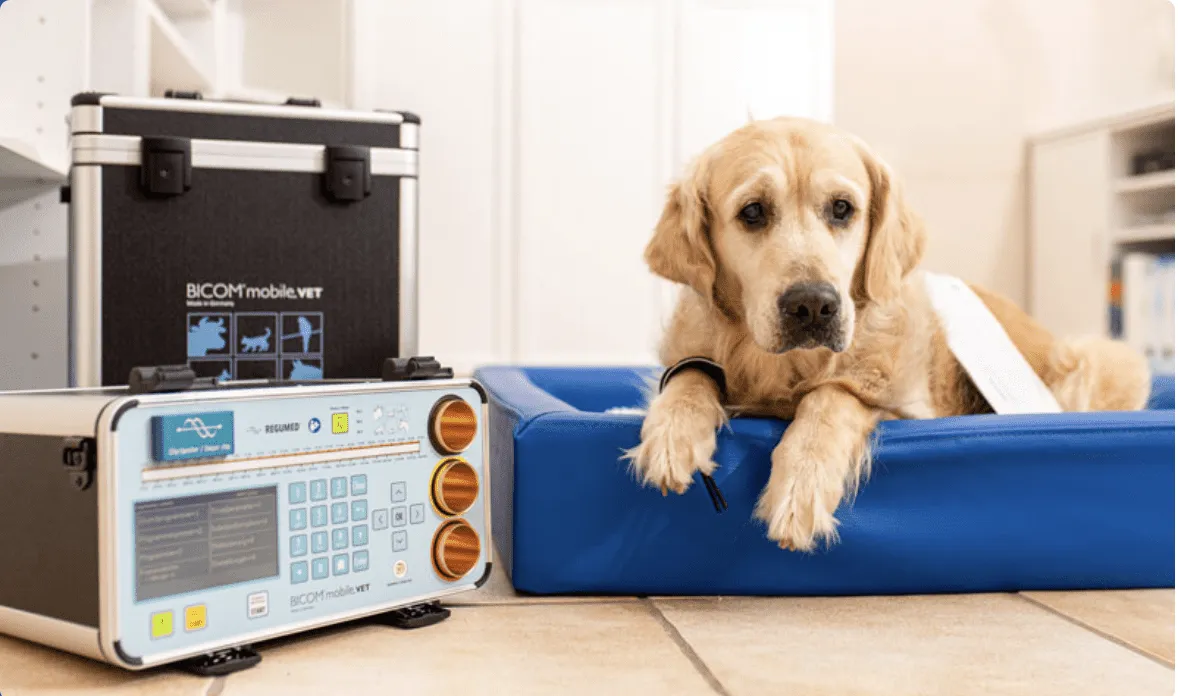



Request more information
Quick Links
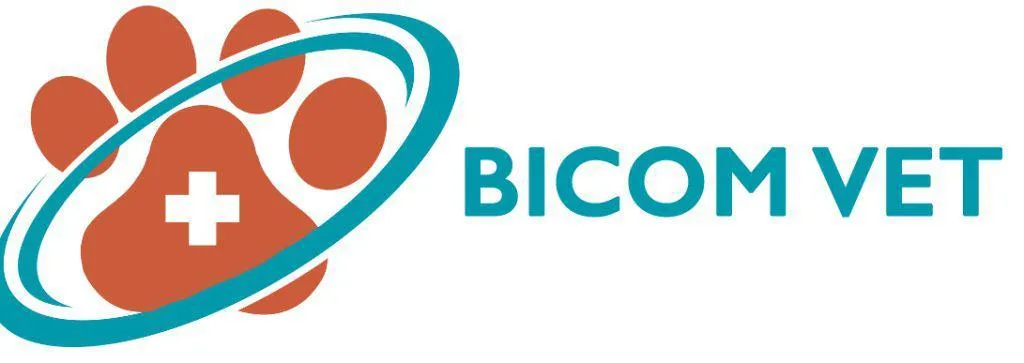

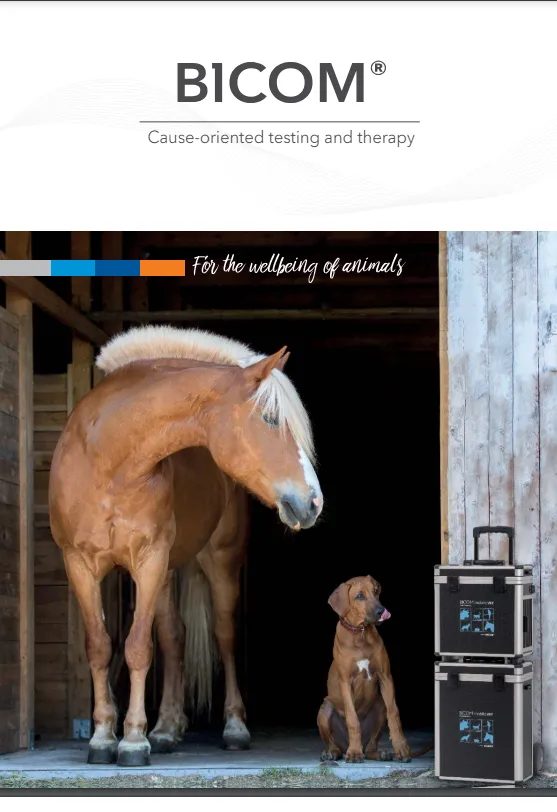

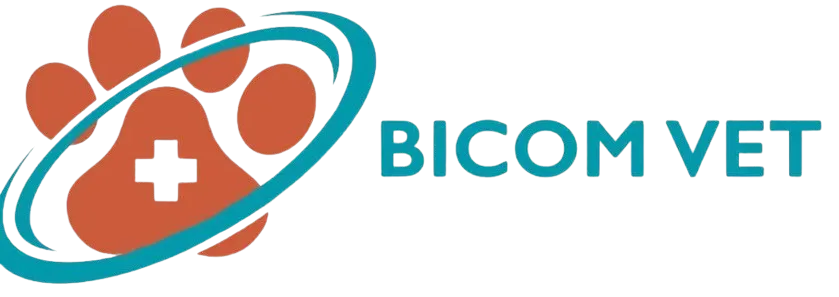
Facebook
Instagram
Mail